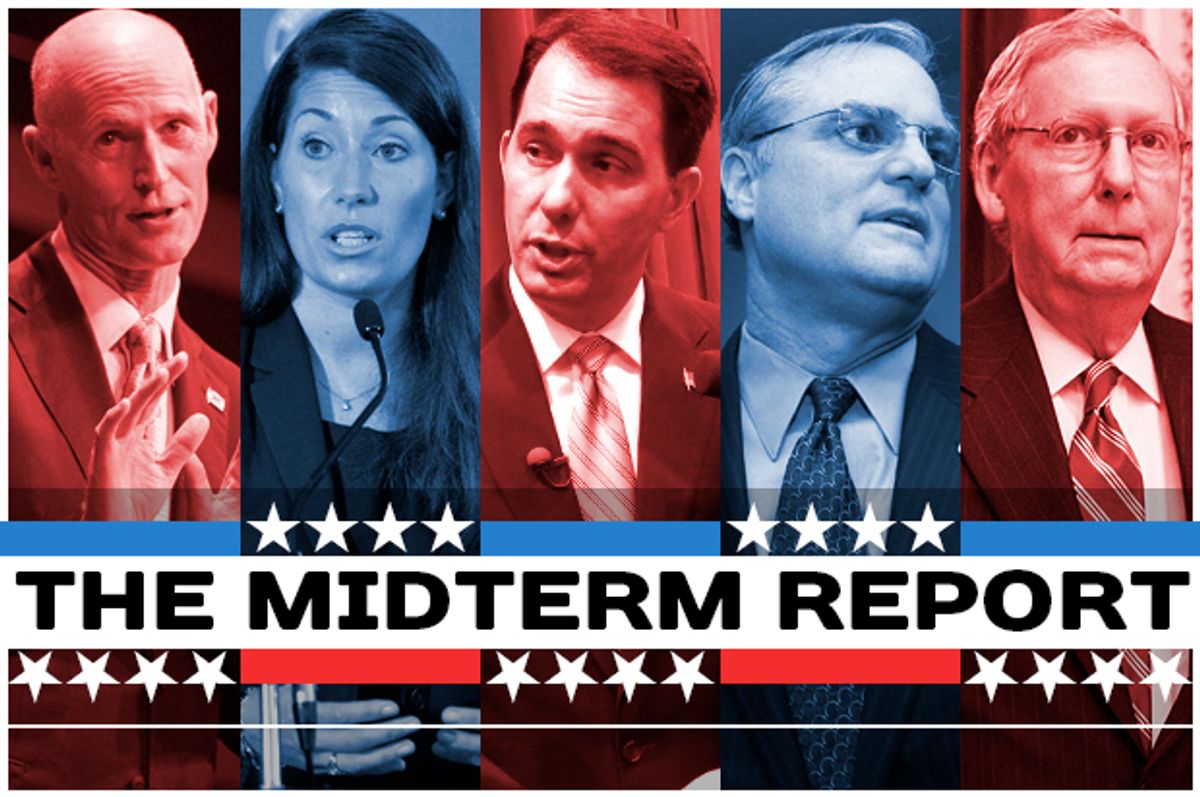In recent weeks, the conventional wisdom held that Senate control would come down to pure tossup races in Colorado, Kansas, Iowa and Georgia. Democrats would need to win three of the four contests in order to maintain power in Congress' upper chamber, assuming they lost seats in Alaska, Montana, Arkansas, Louisiana, West Virginia and South Dakota. Given the national political headwinds, that was always a tall order, but it was far from impossible. But embedded in that scenario was the assumption that Democratic Sen. Kay Hagan of North Carolina would hold on to her seat -- and recent polling suggests that while Republican Thom Tillis hasn't quite erased Hagan's tiny edge in the race, the contest is poised to go down to the wire. And that, in turn, could pose a significant complication for Democrats seeking to hold onto Senate power.
Hagan entered the 2014 cycle as one of Senate Democrats' most endangered incumbents. But Hagan proved surprisingly resilient in the face of an early right-wing onslaught from Koch-backed outside groups, and she had the good fortune of drawing a deeply flawed opponent. As speaker of North Carolina's state House, Tillis is the legislative face of the state's unpopular education cuts, antiabortion legislation, and voter suppression measures. By late September, Hagan had built an average lead of about 4 or 5 points over Tillis. She wasn't exactly a prohibitive favorite, but there was no question that Hagan had the advantage heading into the race's home stretch.
But a new wave of anti-Hagan spending on the airwaves and Tillis' demagogic fear-mongering over Ebola and the Islamic State militant group appear to have improved the GOP's position in the Tar Heel state. In head-to-head matchups, Hagan still leads, but only by an average of about 2 percentage points. An NBC News/Marist poll released Sunday morning underscored the increasing competitiveness of the contest, finding both candidates deadlocked at 43 percent. A major X factor in the race is the Election Day performance of libertarian Sean Haugh, a quirky pizza deliveryman who's currently polling at around 5 percent. Some Democrats have long worried that disaffected conservatives would eventually abandon Haugh as Election Day approached, holding their noses and pulling the lever for Tillis. Last week brought further reason for Democratic anxiety about Haugh. A conservative group is now waging an online ad campaign targeting young voters with the message, "Get Haugh, get high!" The ad campaign, dubbed "More Weed, Less War," could depress support for Hagan among left-leaning millennials.
All things considered, though, Hagan still boasts key advantages. While her lead is smaller than it was a few weeks ago, the fact that she has maintained even a small edge over Tillis in a year like this one speaks to her strength in the face of concerted conservative attacks. Moreover, the Democrats' impressive ground game in North Carolina bodes well for Hagan's ability to turn out the young, female and minority voters who are crucial to the party's coalition in the state. There may be a few yellow flags for North Carolina Democrats, but the party is much better-positioned in the state than it is in other Senate battlegrounds. According to Nate Silver's FiveThirtyEight, Hagan still holds a 73 percent chance of keeping her seat.
In other midterms news:
- It was barely a year ago that the fierce backlash over the Tea Party-led government shutdown sparked talk that Democrats could actually recapture the House of Representatives, but now the speculation centers on whether the GOP will match its post-World War II record of 246 House seats. That would require a 12-seat pickup for the GOP -- a bit more than the two to 10 seats most forecasters expect the party to gain. But as the Wall Street Journal reports this morning, Republicans are bullish about their chances for big gains in the House, with new Democratic-held seats in Iowa and Nevada apparently in play. The GOP's investment in those races may ultimately divert attention from other contests in which the party has a better shot, but a historic GOP majority would likely foreclose the possibility of a Democratic House until after 2020 redistricting.
- New polls released over the weekend show relative stability in most marquee Senate races. Polls from NBC News/Marist and CBS/New York Times/YouGov showed little movement in the cycle's top battlegrounds, with one major exception. While Democrats had appeared to make the South Dakota Senate contest competitive, former GOP Gov. Mike Rounds now looks like he has little to worry about. NBC News/Marist's poll gave Rounds a 14-point lead over Democrat Rick Weiland, a result in line with the CBS/New York Times/You Gov survey, which found Rounds leading Weiland by 13 points. Independent Larry Pressler, who represented South Dakota in the Senate as a Republican from 1979 to 1997, finished a distant third in both polls.
- Meanwhile, CBS/New York Times/YouGov shows Democrats poised to do well in this year's gubernatorial contests. Summarizing the results, the New York Times' Nate Cohn writes that Republicans hold slight edges in Kansas, Alaska and Georgia, while Democrats are clinging to small leads in Massachusetts, Colorado, Illinois, Rhode Island and Maine. In Wisconsin, Scott Walker leads Democrat Mary Burke by just 1 point, while Republican Gov. Rick Snyder trails Democrat Mark Schauer by 1 point in Michigan.



Shares